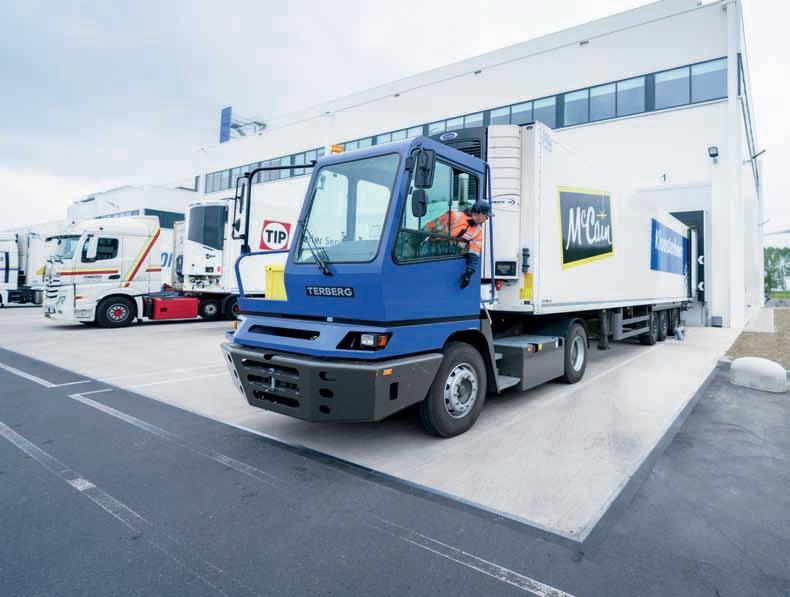
35 minute read
Kloosterboer and McCain
ThE iDEA foR ThE fRiEs ExPREss ARosE AT lAsT yEAR’s fEsTiVE oPENiNg of KloosTERboER lElysTAD.
The Fries Express
7,000 truck rides shift to barge
All photos courtesy of Kloosterboer.
In concrete terms, this means 1,000 trailer trucks (most of which carry two containers) per day off the road and 1,000 more containers that are transported via inland navigation. This will lead to fewer traffic jams and lower CO2 emission levels. If the programme is successful, a similar programme can be introduced for railway transport. Like every plan, things are often easier said than done. A fine example of a modal shift is the so-called Fries Express, which is a recent collaboration between potato fries producer McCain Food Holland and logistics service provider Kloosterboer.
Coldstore Lelystad According to Fred Compeer, General Manager Intermodal of Kloosterboer, the idea was founded in June 2019. “McCain and Kloosterboer have been working together for quite some time now,” he says, “and this is why we regularly meet to discuss the operation. But in this case, the idea for the Fries Express arose at last year’s festive opening of Kloosterboer Lelystad.” “For us, Kloosterboer is an important logistics service provider,” adds Ronald Dees, Project Manager of McCain Foods Holland, “and in the past we have looked into the idea of the modal shift several times, but until now only with a few successes and surely not with the projected volume that we want to move via the Fries Express.”
From truck to barge In the past, 4,500 truck rides were conducted every year from McCain’s production site in Lewedorp (near Vlissingen) to Kloosterboer’s distribution centre in Lelystad, and another 2,500 rides from Rotterdam to Lelystad to load containers. In the new situation, McCain Lewedorp directly delivers the full containers to Kloosterboer Vlissingen for barge transport to Lelystad. From Lelystad, the full export containers are transported by barge to Rotterdam. Furthermore, export containers from local producers of onion/potato products are transported from Lelystad to Vlissingen by barge for further transport to West Africa. For the service, two barges are used that are equipped with reefer plugs to keep the containers refrigerated during transport, and another two barges are under construction.
In intense year After an intense year of preparations, the Fries Express started to operate in August of this year. “Changing volume from road to barge was quite a challenge, not just financially”, Mr Compeer states. He explains, “Transporting something from A to B sounds simple, yet behind this hides a complex process with many aspects that need to be considered. We looked into every aspect
and discussed all variables over the past year. At Kloosterboer a project manager was put on the project to monitor the entire preparative process. We performed four trials to finetune the process before the official take-off, and only then were we convinced that we could commercially start this new service.” “One of the biggest challenges,” Mr Dees states, “lies in the fact that we are dealing with fast-moving goods with a quick turnover that make long-term planning difficult. We soon hope to expand the service to three barges a week. It will then be easier to make any last-minute changes in shipment planning. Goods that are not on time today can then be shipped tomorrow.”
Spend money to make it One of Fries Express’ first objectives is to raise the awareness in the market. “A lot has been said about modal shift from road to barge and with our concept, we want to show that it is feasible”, Mr Compeer voices. He continues, “Like ample new initiatives, we first had to make money to realise this, which is not without risk. We have, for example, made a long-term lease agreement with the barge operator to invest in 60 plugs onto two barges that are presently under construction. Our challenge now is to expand the current two departures per week to at least three. This obviously requires a change of mind in the market. But when looking at, for instance, the area around Lelystad, lots of potatoes and onions are farmed and large volumes of those products are transported to Africa. The farmers are used to trucking and with our project, we now hope to show them the advantages of barge transport.”
‘Be Good and Do Good’ For McCain, the Fries Express has already proven to be worth the effort. “We produce in Lewedorp in Zeeland, as well as in Lelystad”, Mr Dees elaborates. “We also have our distribution centre in Lelystad, which means that fries produced in Lewedorp are transported to Lelystad. From Lelystad, our The Modal Shift Programme The Modal Shift programme is organised by the Ministry of Infrastructure and Water Management, Top Sector Logistics, and the provinces of South Holland, North Brabant, Limburg, and Gelderland. It is dedicated to relocating container transport from the roads to inland navigation. The goal is to bring about a large-scale move, particularly among SME shipping and transport companies, away from container transport by truck and towards transport via inland navigation. Minister of Infrastructure and Water Management Cora van Nieuwenhuizen recently paid a digital work visit to Kloosterboer and she was impressed by the initiatives. “The Fries Express,” she said, “demonstrates that it is absolutely possible to transport goods via inland navigation, instead of by truck. It is a great example of the new form of collaboration with shipping companies and transporters by which we want to bring about a shift from road to water.”
products are transported to Rotterdam for export overseas. As the fries are produced and transported almost year round, they form a solid base for the barge service. Now it will be important to extend our barged volumes with other goods from other producers to make the service more cost-efficient. The credo for McCain’s long-term vision is ‘Be Good and Do Good’. The Fries Express may not be the most profitable solution at this stage, but it certainly helps us to reduce our carbon footprint, which is in fact also a valuable gain.”
i. kloosterboer.nl i. mccain.nl
ThE DUTch MoDAl PRogRAMME is AiMiNg To shifT 2,000TEU PER DAy fRoM ThE RoAD To iNlAND NAVigATioN AloNg ThE RoTTERDAM-VENlo AND RoTTERDAM-ARNhEM/NijMEgEN coRRiDoRs bEfoRE 2040.

The linking pin
Dutch Marine is a fine example of a maritime company that provides high valued support for the industry, even though it seemingly operates more on the background. Since 2012, the enterprise has on offer a broad range of offshore services. With its founder Paul Verschure, the company can rely on over 30 years of maritime experience.
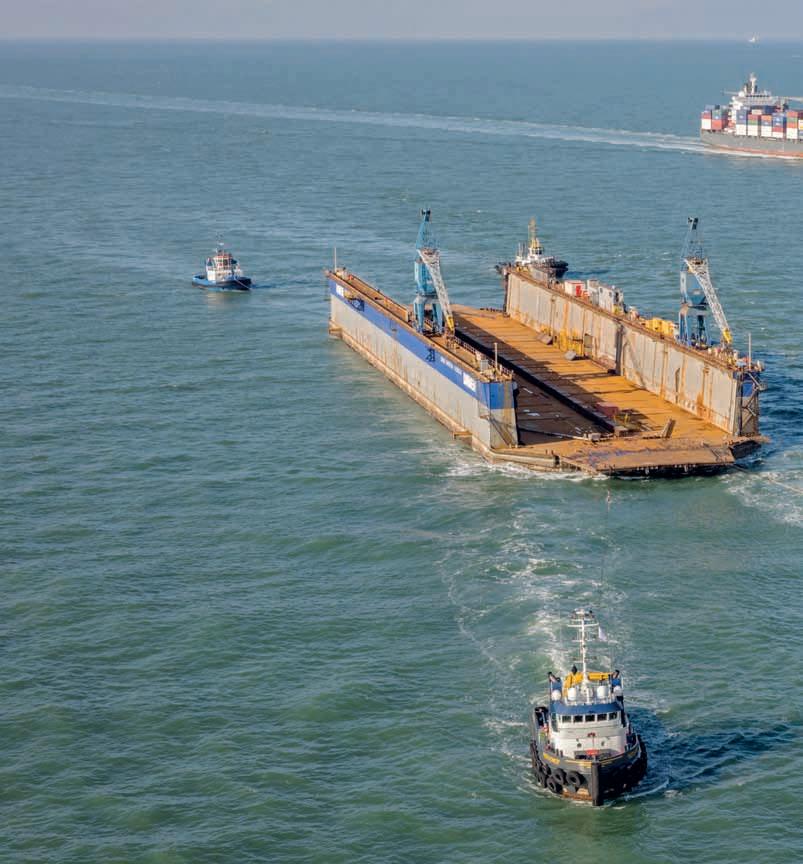
All Photos courtesy of Dutch Marine.
“When looking at Dutch Marine,” Mr Verschure says, “one could say that our characteristics are highly influenced by my personal values. This means that, like myself, the company cannot be easily pigeonholed and acts somewhat nonconformist. We do things differently and are not afraid of challenges. On the contrary, the more difficult a project is, the more we like it. We hence offer a broad range of services such as Maritime Consultancy, Casualty Management, Salvage & Wreck Removal, Towage Services, Technical Support, New Build Projects, and Technical Project Management. Looking for the right solution According to Mr Verschure, operating independently is the best way to act in the client’s mind and interest. “By being independent, I managed to make the company a trustworthy partner for many customers. Our motto is that we don’t stop until our clients’ needs are fulfilled. Of course we cannot do everything ourselves, which is why we rely on a large pool of experienced and trustworthy partners that always want to deliver, just like us. During his years in the maritime industry, working among others, for towage and salvage company Multraship, Mr Verschure has definitively learned a lot. “In
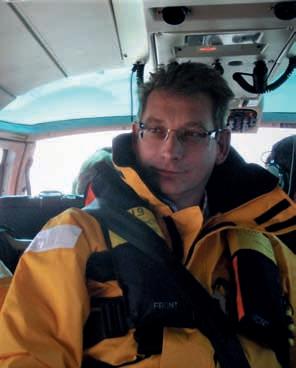
Paul VerSchure, FounDer oF Dutch Marine: “With Dutch Marine, i ForM the MiSSing link betWeen the DeManD anD SuPPly oF MaritiMe SerViceS.”

For DaMen, Dutch Marine took care oF the MobiliSation anD tranSPort oF a Dry Dock FroM a cloSeD ShiPyarD in gothenburg to itS rePair yarD in VliSSingen.
my years of working for various employers, I learned to be creative. I found out that I like to act as a linking pin and with Dutch Marine, I now form the missing link between the demand and supply of maritime services. When one of our customers needs a problem solved, I start looking for the right solution using my own knowhow and experience, and that of my partners.” The company has already executed several interesting and challenging projects. “One of our regular customers is Rijkswaterstaat (the Dutch governmental department of waterways and public works), for which we often act as a consultant for wreck removals”, Mr Verschure explains. “As a governmental organisation, they are used to working according to strict formats and procedures, which can be rather challenging for the companies working for them. But throughout the years, we have become one of their preferred partners. A well-known project that we were involved in was the removal of the Baltic Ace wreck. We were asked to be part of the Rijkswaterstaat technical team. Our scope of work consisted of involvement in the tender process and providing technical advice on alternative salvage methods during the execution of the wreck removal. During this task, Dutch Marine also acted as an observer for Rijkswaterstaat.” The Baltic Ace project is a
fine example of how the company works. “During a project we operate as an independent partner that communicates both transparently and honestly. It is in our interest that the projects we take care of are successfully executed. Not just for us, but for our customer as well,” Mr Verschure states.
Acting without bias As an outsider, Dutch Marine can act towards customer and its employers without any bias. “For Damen, we took care of the mobilisation and transport of a dry dock from a closed shipyard in Gothenburg to its repair yard in Vlissingen. It was very convenient for Damen that we could move around freely within the organisation with our questions and remarks, as this resulted in a smoother project process.” And this certainly did not prove to be a luxury. Towing a dry dock overseas is usually no big deal, but things in this case turned out to more complicated than expected. Mr Verschure continues, “Our assignment was quite simple. Damen wanted us to reactivate and prepare a 270m x 45m floating dry-dock from a closed shipyard for sea towage from Gothenburg to Vlissingen. But behind this simple question hid a complex and extensive operation. It started with the fact that the dry dock had been out of use for a longer period and we therefore first had to work on a thorough inspection, workplan, and budget. Before carrying out the transport and the usual mobilisation works such as sea-fastening equipment, the construction of towing connections and fairleads and bollards, and providing a towing plan, other additional preparations were first necessary. We had to, for instance, handle dangerous materials like asbestos. The dry dock had to be reinforced, stolen parts such as copper
Dutch Marine haS been able to builD a gooD track recorD oF SucceSSFul ProjectS anD SatiSFieD cuStoMerS throughout north WeSt euroPe. a Well-knoWn Project that Dutch Marine WaS inVolVeD in WaS the reMoVal oF the baltic ace Wreck.
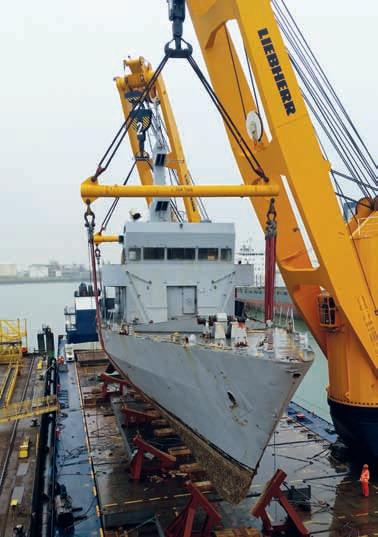
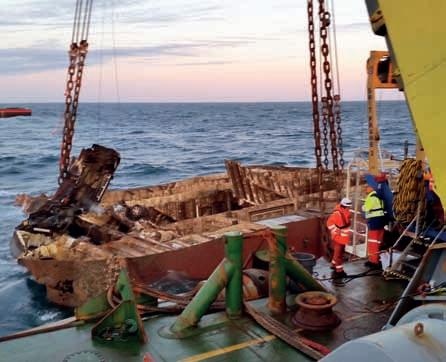
wirings had to be renewed, and both 200t cranes had to be reactivated, including load tests. So unsurprisingly, it was indeed quite a challenge to manage both time and budget, and it took us twelve months to safely deliver the dry dock in Vlissingen, including eight months of waiting for a favourable weather window for the actual transport.”
Taking over ownership The Damen project showed how a company has ample trust in Dutch Marine’s capabilities. “We represented Damen for the full 100% throughout the entire project,” Mr Verschure clarifies. “We discovered that by doing so, a total of 55 companies and government bodies were involved and we had to act as a linking pin between all of them and Damen.” Following this project, Dutch Marine has since been contracted by Damen for other dry dock transports, which shows the Dutch shipyard company’s satisfaction with how this maritime service provider works. “It is our aim,” Mr Verschure continues, “to take a lot of work out of our customers’ hands, more or less by taking over the ownership of their project. Rather than a project requiring a lot from the staff of a company, we take care of it completely. We have hence been able to build a good track record of successful projects and satisfied customers throughout North West Europe. Many of these projects have resulted in new assignments, which is certainly good for us. The maritime industry is a small world, with reputations broken down faster than they are built up. So in order to stay successful, it is evidently important for us to stick to our values of openness, honesty, and reliability.”
THe liNeR SeRvice To ANd fRom TeRNeuzeN iS execuTed by fouR RoRo cARRieRS oPeRATed by WAgeNboRg (bAlTicboRg, PicTuRed, ANd boTHNiAboRg) ANd HolmeN (exPoRTeR ANd SHiPPeR).

All photos courtesy of Wagenborg Agencies Terneuzen.
Setting up shop
Wagenborg Agencies Terneuzen
Prior to 2020, Royal Wagenborg was represented by its own shipping agencies in nearly all major ports in the Netherlands. However, one port remained on its wish list: North Sea Port. That changed last June, when the shipping company finally established an agency office in Terneuzen.
Wagenborg Agencies operates in all Dutch ports and can be contacted 24/7 year-round for services including husbandry, protective agency, bunker calls, and liner & tramp agency. In addition, Wagenborg Agencies also services several European ports from her branch offices in Tarragona (Spain), Malmö (Sweden), and Pireaus (Greece). According to Xander Blom and Koen Speijer, Wagenborg’s Commercial Line Agents in Terneuzen, the office in Terneuzen was a logical step for Wagenborg. “Wagenborg already had a weekly liner service between Terneuzen, Haraholmen (Piteå), Bremen, Sheerness, Terneuzen, Cuxhaven, and Södertälje”,
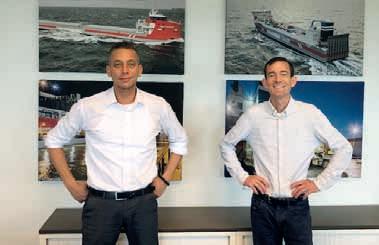
commeRciAl liNe AgeNTS KoeN SPeiJeR (lefT) ANd xANdeR blom of WAgeNboRg AgeNcieS TeRNeuzeN.
explains Mr Blom. “When a second liner service was added this spring frequenting Halstavik, Braviken, Lübeck, Sheerness, and Terneuzen, the time was right to gain a foothold in the region.” The company until recently outsourced the agency services for its vessels in the port of Terneuzen. By establishing a Wagenborg agency within North Sea Port, the shipping company can provide those services itself, while also increasing commercial strength in the area. From the Terneuzen office, Wagenborg Agencies will promote its liner service to Sweden, as well as other services it offers such as Projects and Logistics, Shipping, Towage, and Offshore.
Spreading the word When Mr Blom and Mr Speijer started out five months ago, their initial focus was on Wagenborg’s liner services, with two vessels visiting Terneuzen every week. The liner service is executed by four RoRo carriers operated by Wagenborg (Bothniaborg and Balticborg) and Holmen (Exporter and Shipper). “We can basically ship anything on board: from containers to cranes, from rolling equipment to breakbulk or project cargo”, says Mr Blom. Before the agency in Terneuzen was set up, booking return cargo on Wagenborg’s liner service was primarily done from the branch office in Malmö. Mr Blom and Mr Speijer now take care of the bookings, especially for northbound cargo. “The important thing for us at present is brand awareness in the region”, explains Mr Blom. “We are still relatively new in the area. Word needs to spread, many vessel owners and captains have not yet heard about the Terneuzen agency”, he continues. “And many operators may know that we provide agency services, but not that we also serve as a booking office for brokerage. So we are talking to forwarders, and trying to make ourselves known in the North Sea Port community.”
A good move Needless to say, mid 2020 was a trying time to start a new agency. But luckily, things are going as planned for Mr Blom and Mr Speijer. They hope to establish more lasting partnerships in the near future, and expand their agency services towards third parties. Moreover, they are currently in the starting phase of a feasibility study with ferry trailers. “Setting up the Terneuzen agency was substantiated due the liner services, but based on the positive reactions we receive from both Wagenborg and external parties, we can see that it was a good move”, states Mr Speijer. “It was high time for us to establish local representation.”
Exploring potential Apart from securing (return) cargo for the liner services and handling third-party agency calls, Wagenborg Agencies Terneuzen is exploring further potential projects in the North Sea Port region. “Acting as agents for our RoRo liners is currently our primary service. Yet we are in a very different position than if we would have started an independent two-person agency”, voices Mr Speijer. “We are backed by a very large name in the industry, so opportunities often present themselves to us. We can handle any type of vessel. Especially combined with our heavy-lift division Nedlift and our offshore division, big things could certainly happen”, he adds. In time, Wagenborg Agencies Terneuzen aims to cater not merely to vessels visiting Terneuzen and Vlissingen, but to expand its service to Ghent, Antwerp, and potentially Zeebrugge. Mr Blom and Mr Speijer expect the new lock in Terneuzen to have a particularly positive effect on shipping within North Sea Port. Allowing ships faster passage will further increase the attractiveness of Ghent and Terneuzen for shipping companies.
About Wagenborg Wagenborg Agencies Terneuzen is a member of Royal Wagenborg. Founded by Egbert Wagenborg in 1898 and headquartered in the Ems region in the port of Delfzijl, the shipping company has been privately owned by the Wagenborg

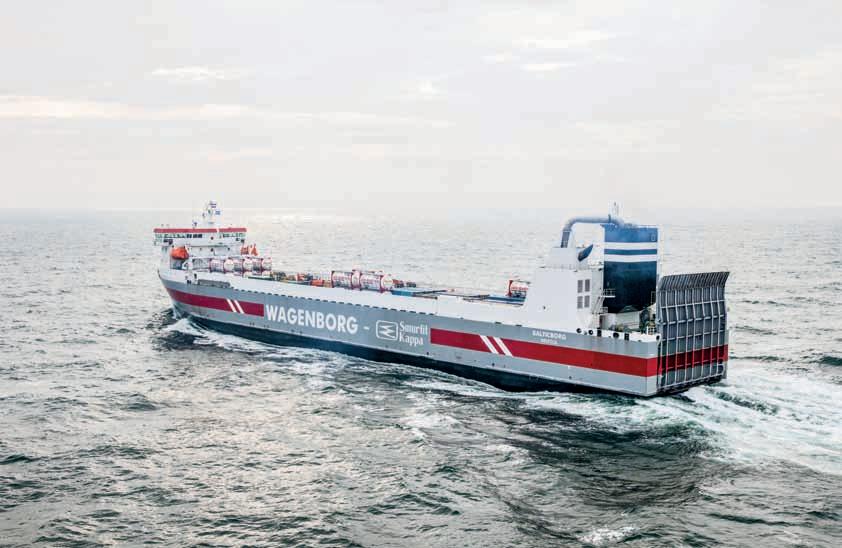
THe liNeR SeRvice SuPPoRTS THe SHiPmeNTS of mANy TyPeS of goodS SucH AS foReST PRoducTS, uNAccomPANied AuTomoTive, coNTAiNeRS ANd bReAKbulK cARgoeS, ANd PRoJecT goodS.
family since its inception. The early business of Wagenborg was all about the timber trade and involved shipping within the Baltic, on the North Sea, and the Mediterranean Sea. Throughout the years, Wagenborg continued to increase its fleet size and expand activities, gradually transforming into a maritime logistics conglomerate, with roughly 3,000 employees at present. Approximately 200 vessels fall under the Wagenborg flag, 120 of which are owned by the shipping company, while the other 80 are captain-owned. Wagenborg has its own terminals in the ports of Eemshaven and Delfzijl. The maritime company has a separate heavy-lift division called Nedlift, and is active in the offshore industry, for which the shipping company had several vessels built on spec. Having their own vessels and heavy-lift equipment enables Wagenborg to execute turn-key mobilisation projects. The company is also becoming more active in the wind energy sector. Wagenborg operates as tramp agent for parties with cargo interests, handling dry and liquid bulk cargoes and project cargoes in various Dutch ports. In addition, Wagenborg acts as a liner agency for several liner services between the Continent and Scandinavia.
Royal Wagenborg has divided its logistics service portfolio into several divisions: • Wagenborg Shipping (including Projects & Logistics). • Wagenborg Offshore (including Wagenborg Foxdrill). • Wagenborg Towage. • Wagenborg Stevedoring (including Agency Services). • Wagenborg Passenger Services. • Wagenborg Nedlift (Heavy-Lift Division). • Niestern Sander (Shipbuilding/Repair/Conversion/Refit).
Wagenborg’s mission is creating transportation solutions and implementing these for customers. The company continuously invests in various means of transport to serve the needs of a broad variety of customers by sea, shallow water, and road, offering a complete chain of transport. Wagenborg companies are involved in shipping, stevedoring, forwarding, crane rental, heavy lifting, heavy transport, oil & gas-related services, towage, and passenger services. Royal Wagenborg has identified quality, health, safety, and the environment as key factors. Wagenborg Shipping manages quality according to ISO 9001, ISO 14001, and AEO. Its cargo vessels are ISM and ISPS-certified.
The highest quality
Baker Tilly supports AMC Vlissingen in audit, tax, and various advisory services
The companies at North Sea Port generate a large amount of jobs. It is estimated that around 50,000 persons are directly employed. On top of this, about the same amount of employment is indirectly generated from companies that are providing all kind of services to the port. One of these company is accountant and tax adviser Baker Tilly.
Armando Hermes is Senior Manager of Baker Tilly’s Zeeland office in Goes. “Baker Tilly helps entrepreneurs solve many issues”, Mr Hermes says. “At Baker Tilly, we are more than just accountants and tax advisers. We offer a full range of services, including statutory audits, advice on VAT, advice on customs, HR (including employment law consulting), corporate finance, financial staffing, IT advise, and business strategy.”
Backbone Mr Hermes continues. “With a focus on serving top of the middle market, including family-owned companies, we help our clients plan for the future and stay on track to achieve their goals. Clients include both SMEs and large enterprises, non-profit organisations, and the public sector. We have clients and experience in multiple industries and segments such as the construction industry, government, horeca & leisure, fishery, and care. When we noticed an inevitable decline in business in one of our core sectors, we decided to expand the focus of our activities towards one of the backbones of the Zeeland economy, the seaport.”
AMC Vlissingen One of the customers for Baker Tilly at North Sea Port is AMC Vlissingen, which is one of the international sites of AMC Natural Drinks. AMC Natural Drinks is one of the two holdings of AMC Group, a third-generation family company founded in 1931, and today the third largest Spanish food company in international sales. “AMC Natural Drinks can be considered as one of the European innovation leaders in chilled fruit juices, smoothies, veggie drinks, plant yoghurts, and plant ‘mylks’”, Mr Hermes explains. He continues, “With AMC Vlissingen, the company has one of the most modern natural drinks factories in Europe, which in the past six years has been solidly growing. It recently successfully finished its third division, which also covers new plant-based and dairy alternative drinks


AMC VlISSINgeN IS lOCATed AT The BIjleVeldhAVeN.

Photo courtesy of Baker Tilly.

BAker TIlly gOeS IS ONe Of The COMPANIeS CONTrIBuTINg TO lOTS Of INdIreCT eMPlOyMeNT AT NOrTh SeA POrT.
ArMANdO herMeS, SeNIOr MANAger Of BAker TIlly’S ZeelANd OffICe IN gOeS: “WheN AMC NATurAl drINkS deCIded TO Seek A duTCh PArTNer fOr TheIr ACTIVITIeS IN VlISSINgeN, Our OffICe IN gOeS WAS AN OBVIOuS ChOICe.”
Photo courtesy of Baker Tilly.
Photo courtesy of AMC Natural Drinks.
AMC’S PrOduCTS Are SOld All OVer eurOPe frOM VlISSINgeN ANd BAker TIlly OfTeN helPS TheM WITh eNTerINg NeW MArkeTS.
categories. It also has ambitious carbon-neutral sustainability goals as one of its pillars. Looking at these achievements, one can imagine that having this company as a customer in the port area is something we are very proud of.”
Specialist for every subject The AMC Vlissingen site is mainly a production facility for AMC Natural Drinks, without any additional supporting departments. Therefore, the company decided to reach out to a Dutch accountant. Being part of the international Baker Tilly network was one of the reasons why Baker Tilly in Goes became involved with AMC Vlissingen. “Baker Tilly was already doing business with AMC’s head office in Spain and when they decided to seek a Dutch partner for their activities in Vlissingen, our office in Goes was an obvious choice”, Mr Hermes voices. “AMC always goes for the highest quality and that is why they rely on our expertise, instead of figuring out everything themselves. They know our values, they know our extensive expertise, and they know that we have specialists for every subject involving accountancy, tax, and advisory.” More than just an accountant Operating in the Netherlands, AMC has to adapt to Dutch law and regulations and Baker Tilly acts as the company’s adviser in many subjects related to, among other things, law, taxes, and customs. “We are more than just an accountant for AMC. This is of course one of our main tasks, but our services go much further. AMC’s products are sold all over Europe from Vlissingen and with our international network of offices throughout the world, we have gained a lot of experience in international rules and regulations concerning logistics, export, imports, and international business in general, so we often help them with entering new markets. Working with international employees in Vlissingen, AMC also consults us for HR issues. Since 2018, we have already helped AMC with many challenges. We know that the company is aiming for further growth, and of course we look forward to help them realise their futures targets.”
i. bakertilly.nl i. amcnaturaldrinks.com
The NOrTh-C-MeThaNOl prOjeCT eNTails The CONsTruCTiON Of TwO large-sCale deMO plaNTs aNd suppOrTiNg iNfrasTruCTure ON The rOdeNhuize peNiNsula iN NOrTh sea pOrT.

Multi-million-euro project transforms CO2 into green raw material
Ten private and public sector partners recently marked the launch of the NorthC-Methanol project. Together, they will annually reduce CO2 emissions by 140,000t. They will also locally generate 44,000t of green methanol, which can be used as feedstock for the chemicals and renewables industries, as well as for fuel for ships and trains.
This CO2 reduction is equivalent to the carbon absorption of around six million trees per year. This is a world-class project and is expected to have the largest renewable hydrogen-tomethanol complex in the world.
Demo plant North-C-Methanol is the first large-scale demo project that is part of the North-CCU-Hub programme, and at present represents an investment of EUR 140 million. The North-CCUHub programme’s long-term objective is to realise an overall annual reduction in CO2 emissions of 1t million at North Sea Port. The formal collaborative agreement for the North-CMethanol project demonstrates the need for a sustainable perspective for the future. The partners will contribute a large part of the investment, and Flemish and European support is also being looked at.
Largest plants of their kind North-C-Methanol entails the construction of two large-scale demo plants and supporting infrastructure on the Rodenhuize peninsula in North Sea Port. The first plant, a 65MW electrolyser, is being erected on the ENGIE site. This hydrogen
1 2
3 4 5
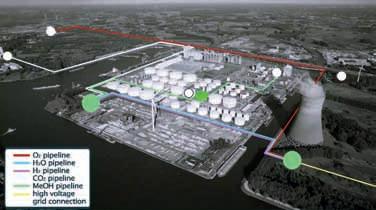
6
plant will convert water into green hydrogen and oxygen using wind power. The second plant, a Proman methanol plant on the Rodenhuize peninsula, will use this green hydrogen to convert the collected CO2 emissions of major local industrial players, such as ArcelorMittal and Alco Bio Fuel, into green methanol, also known as renewable methanol. The local chemicals and renewable fuel industries like Cargill can in turn use the methanol as a green raw material and/or as a green fuel for marine vessels and railroads.
Circular showpiece The North-C-Methanol project is a landmark example of sustainable industrial symbiosis: raw materials are locally extracted, and fi nished products and secondary fl ows are locally used. A new, circular economy will be created in North Sea Port, in which waste from one enterprise will be used as a raw material by another one. All by-products of the methanol production process, including oxygen, heat, and water, will also be locally recycled. This will ensure a unique and far-reaching industrial and circular integration. This will of course go hand in hand with building a lot of supporting infrastructures such as new pipelines and storage tanks, in order to transport raw materials, by products, and fi nished products to the correct location. Fluxys and Oiltanking will be responsible for this, with Mitsubishi Power overseeing the integration and coordination of the entire construction process.
1. Carbon dioxide from industrial sources. 2. ArcelorMittal, oxygen used locally. 3. North-C-Methanol, synthesis unit. 4. Oiltanking, storage for green methanol. 5. Cargill, off-takes of the green methanol. 6. Engie, electrolyser unit North-C-Methanol 380/150kv station. 7. Bio Base Europe Pilot Plant, innovation tractory partner.
Impact on a global scale Besides the highly advanced integration of the various processes and among differing industrial partners, the NorthC-Methanol project is also unique with regard to its scale and innovation programme in the medium and long term. Electrolysis capacity is indeed expected to be six times greater than the largest system currently in worldwide use. North-CCU-Hub expects a gradual increase of the North-CMethanol capacity from 65MW in 2024 to 600MW in 2030, as part of an evolving programme in which new technologies, markets, and products such as ammonia, formic acid, fatty acids, esters, and proteins will gradually be developed and integrated. Expert partners UGent, Bio Base Europe Pilot Plant, CAPTURE, and the Flemish spearheading clusters Catalisti and Flux50 are shaping these innovation pathways.
I. NORTHSEAPORT.COM
Start CCU hub preliminary study North-C-Methanol Demo plant 63MW electrolyser 45,000t/y methanol North-C upgrade to extra large 600MW electrolyser methanol, ammonia and formic acid synthesis
Joint Development Agreement for rst large scale demo North-C upgrade to full scale 300MW electrolyser Methanol and ammonia synthesis

Innovation Trajectory including Flemish Moonshots and European Subsidy Programs New Demos to be identi ed
Great green ambition
Smart Delta Resources publishes regional plan
The energy transition has in recent years started to take shape. The goals are clear: 49% less CO2 exhaust by 2030, and 95% less by 2050. Some incredible green projects came to life in the North Sea Port region over the last few years. Yet according to the multiannual regional plan recently released by Smart Delta Resources this was just the beginning.
SDR’S NewlY ReleaSeD RegiONal PlaN 2030-2050 iNCluDeS ambiTiOuS, YeT CONCReTe aimS.

Smart Delta Resources (SDR) is a consortium of industrial and public companies that was established in 2014 to assert the industrial significance of the Scheldt Delta region by improving the industry’s sustainability and its competitive position. The companies affiliated with SDR are diverse; the sectors in which they are active range from food, fertilisers and chemical products, to steel and energy. This unique mix of expertise provides a great opportunity for synergetic advantages in energy transition.
Regional plan 2030-2050 SDR’s newly released regional plan includes ambitious, yet concrete aims. It offers an integrated perspective on the steps required to achieve climate neutrality by 2050. Around fifteen companies, all located between Bergen op Zoom, Vlissingen, Terneuzen, and Ghent, have taken on a pioneering role in energy transition, looking to meet the objectives determined by the Netherlands, Belgium, and Europe to halt climate change. Reaching the cluster’s climate goals is essential for the climate agreements in both the Netherlands and Flanders.
CO2 reduction path SDR has formulated a CO2 reduction path that can guide the Scheldt Delta region in cumulatively reducing its carbon dioxide exhaust with 11Mt by 2030, with a tentative reduction ambition of 18,4Mt by 2050. This reduction path is based on four closely interwoven value chains, namely hydrogen, CO2, electricity, and heat. The value chains include all steps, from producing the energy source or carrier right up to its application. The hydrogen and CO2 value chains encompass the production, transport, and application of blue and green hydrogen, and the capture, transport, and storage of CO2. The third value chain, which is heat, encompasses the capture, transport, and application of residual heat and geothermal energy. The final value chain encompasses the generation, transport, and application of electricity. Electricity generation will increasingly focus on climate-neutral energy sources. Application will concentrate on hydrogen production, electrification, and realising efficiency improvements in production processes. These technologies will probably become more cost-effective and usable due to further developments in the coming decades.
Priority programmes Based on the value chains, SDR has set up four priority programmes: Hydrogen Delta, Carbon Connect Delta, Spark Delta, and Heat Delta. All four programmes have already commenced, with clear goals and milestones set for both 2030 and 2050.
Hydrogen Delta Hydrogen Delta is aimed at making the industry more sustainable by phasing out grey hydrogen and replacing it with green, blue, yellow, and possibly orange hydrogen. The programme aspires to position the region as the largest hydrogen cluster of the Netherlands, Flanders, and even Europe, by becoming a largescale producer, user, importer, and exporter of green hydrogen. The current and future regional demand for hydrogen is immense. The Scheldt Delta region has an annual industrial consumption of 580K tonnes of hydrogen, which is the largest regional hydrogen usage in the Benelux. The large hydrogen consumption makes the region a great location for establishing a hydrogen hub.
faCiliTaTeD bY
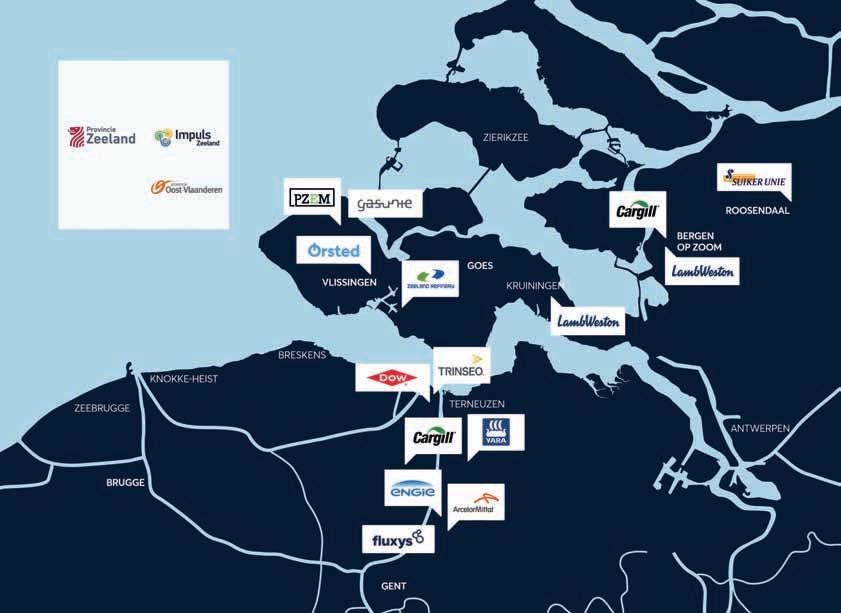
Photo courtesy of Arcelor Mittal
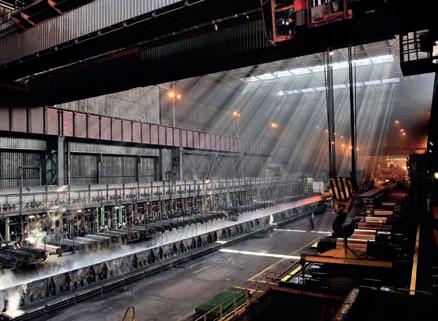
PaRTieS iNVOlVeD iN CaRbON CONNeCT DelTa iNCluDe amONg OTheRS, aRCelOR miTTal.
When grey hydrogen is produced, natural gas is split into hydrogen and carbon dioxide by reforming steam. The CO2 can be captured and stored (CCS) in empty gas fields, turning the hydrogen production ‘blue’. Green hydrogen is produced with
SmaRT DelTa ReCOuRCeS PaRTiCiPaNTS. aROuND fifTeeN COmPaNieS, all lOCaTeD beTweeN beRgeN OP ZOOm, VliSSiNgeN, TeRNeuZeN, aND gheNT, haVe TakeN ON a PiONeeRiNg ROle iN eNeRgY TRaNSiTiON.
renewable energy sources, whereby water is split into oxygen and hydrogen through electrolysis. Large-scale production of green hydrogen in the Scheldt Delta region offers a tremendous opportunity to replace the current regional grey hydrogen consumption, thus quickly reducing CO2 exhaust gases. By mid-2030, an annual CO2 reduction of two million tonnes could be achieved by producing hydrogen, with a continued growth expected to reach over 3.5t million annually by 2040.
Carbon Connect Delta
At present, the cross-border Scheldt Delta region exhausts 22Mt of CO2 every year. The Carbon Connect Delta Programme aims to annually capture 1Mt CO2 by 2023, expanding to 6,5Mt of CO2 by 2030. By doing so, the programme delivers a substantial contribution to the Dutch industrial task of reducing greenhouse gases with 19,4Mt each year by 2030. Parties involved in Carbon Connect Delta include Arcelor Mittal, Dow, Fluxys, Gasunie, Province of East Flanders, Province of Zeeland, PZEM, North Sea Port, SDR, Yara, and Zeeland Refinery. Applying carbon capture and storage (CCS) and carbon capture and utilisation (CCU) is of crucial importance in the initial phases of the hydrogen transitional path.
• SDR companies are part of the innovative global top. • (In)direct employment for 100,000 people. • Significant potential CO2 reduction of more than 20Mt per year. • 580Kt of hydrogen production and consumption per year, 1/3 of the Netherlands. • Rapid landing of wind energy provides opportunities for production/use of green hydrogen directly on coast.

wiNDfaRm
NuCleaR POweR PlaNT
PORT
gReeN eNeRgY
The CO2 ReDuCTiON PaTh iS baSeD ON fOuR ClOSelY iNTeRwOVeN Value ChaiNS: hYDROgeN, CO2, eleCTRiCiTY, aND heaT.
Spark Delta Programme The energy transition in industrial processes feeds the need to renew electricity infrastructure. This is the Spark Delta programme’s domain. Projects in process optimisation also fall under this priority programme. The energy transition will have a strong impact on the power grid. As a result, Spark Delta aims to pave the way for a robust and cost-effective power grid that can transport the explosive amount of electricity required. The demand for sustainable electricity creates great opportunities, especially in the hydrogen and electricity value chains, through large-scale hydrogen production (Hydrogen Delta), the production of chemical compounds based on hydrogen such as methanol and ammonia, and by electrifying the industry (Heat Delta, Power2Heat, Power2Products).
Heat Delta Programme Heat Delta is rooted in realising the application of residual industrial heat in the built environment and within the industry, and in the application of geothermal heat. Considering the large amount (and surplus) of residual heat that is released during electrolysis and other production processes, this value chain is extremely relevant in the SDR region. In the Ghent-Terneuzen
Channel zone and Vlissingen area, research is being conducted on reusing industrial heat for the heating grid in residential areas. Apart from studies investigating the options to reuse industrial heat in the built environment, various successful industry-toindustry connections for reusing residual heat have already been established: • Between Yara and the horticulture sector (WarmCO2), saving approximately 55Kt of CO2 each year. • Between Zeeland Refinery, Covra, and Martens Cleaning (residual heat), saving around 5K tonnes of CO2 annually. • Between Lamb Weston/Meijer and Wiskerke Onions, saving around 1Kt of CO2 per year. • Between Stora Enso and Volvo, annually saving approximately 15Kt of CO2.
a gReaT examPle Of SmaRT DelTa ReSOuRCeS’S ambiTiOuS PlaNS iS The ReCeNT aNNOuNCemeNT bY ØRSTeD aND YaRa abOuT Them haViNg jOiNeD fORCeS TO PRODuCe gReeN ammONia baSeD ON ReNewable hYDROgeN.

Ørsted and Yara to produce green ammonia A great example of Smart Delta Resources’s ambitious plans is the recent announcement by Ørsted and Yara about them having joined forces to produce green ammonia based on renewable hydrogen. Their project will lead to an annual reduction in CO2 emissions of 100Kt. Ørsted is the largest offshore windfarm developer in the world. The company’s site in Vlissingen serves as operating base for the construction and maintenance of offshore windfarms Borssele I & II. Fertiliser producer Yara has one of its largest plants along the Ghent-Terneuzen Channel in Sluiskil. This is where the Norwegian company wants to set up the production of environment-friendly fertiliser based on green ammonia. Green electricity from the windfarms off the coast of Zeeland can be used to produce CO2-free hydrogen in the 100MW electrolyser that will be installed at Yara Sluiskil. The green hydrogen will substitute grey hydrogen from fossil sources for the annual production of some 75Kt of green ammonia. When everything proceeds according to plan, Yara will commence using the green ammonia for part of its production process in 2024 or 2025, which will result in a reduction in CO2 emissions of 100Kt – the equivalent of taking 50,000 traditional cars off the road. Apart from serving as a raw material for the production of fertiliser, ammonia also has potential as a future climate-neutral marine fuel. Ammonia could eventually generate an additional sales market and contribute to a greener shipping sector.
• Between IVAGO and Ghent University Hospital. • Between Arcelor Mittal Ghent and the municipality of
Zelzate.
Exploding demand for sustainable energy The four value chains have one thing in common: they all depend on significant amounts of energy that must be generated more sustainably for the energy transition to succeed. To transform production processes to be more sustainable and electrified in the future, the total demand for electricity is estimated to rise to 5,200MW by 2050. The turning point will be around 2025, when demand is predicted to rise significantly to 2,300MW. Anticipating this turning point is critical. Wind energy generated at sea (Borssele I & II and Borssele III & IV, which will generate around 1.5GW in the coming years, as well as the landing of IJmuiden Alpha Ver, which could add another 2GW) and both wind and solar energy generated on land (Regional Energy Strategy Zeeland) will play a pivotal role in fulfilling this demand.
Key conditions The economical added value of the industrial cluster is of great importance to Zeeland. It is estimated at approximately EUR 5.6 billion, and creates 33,000 FTEs in direct and indirect job opportunities. Looking at the cross-border port area of North Sea Port, the numbers are even greater: approximately EUR 14.5 billion in added value, and 100,000 FTEs. The European Green Deal and the Dutch Climate Agreement will both have a massive impact on the industry by achieving the Paris Climate Agreement goals. The coming years will bring many challenges such as investment choices concerning operational installations, energy carriers, energy sources, and industrial processes. New technological breakthroughs and upscaling innovative technologies are essential for the industrial transition. Ample significant technologies are still in the infancy stage, unaffordable or inapplicable on an industrial scale. Renewing the energy infrastructure is a crucial condition for success. The companies united in Smart Delta Resources are willing and able to invest in energy transition. Yet they require the support of the governments involved, which should facilitate them by constructing new infrastructure, adapting regulations with cross-border consistency, and making available the financial means required in the context of international competition. Fundamental to realising these programmes are the development of a regional infrastructure for hydrogen, an integral CO2 infrastructure on behalf of CCUS, and the realisation of 380kV in Terneuzen area Zeeuws-Vlaanderen, as well as the availability of sufficient sustainable energy. To achieve this, the region will need to intensively collaborate with the Dutch and Flemish ministries, as well as with the network operators that will also play a key role. Since major infrastructural developments require long-term planning, important decisions should be taken by the government(s) within the next two years. The Dutch-Flemish collaboration deserves specific attention, as cross-border cooperation also presents challenges. There are differences in regulations at play, both politically and administratively, and both countries have indicated disparate time frames and methods to realise CO2 reduction across their industries. The cooperation between both governments and companies is however solid and durable, and the region’s shared goal of becoming more sustainable has created a strong bond. Working together cross-border provides additional opportunities in terms of critical mass, in scale with regard to accessing various financing instruments, as well as in the development of infrastructure across borders. As a matter of fact, the merger between the ports of Zeeland Seaports and Ghent into North Sea Port in 2018 serves as a strong example.

